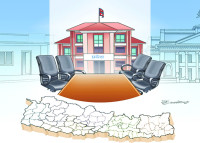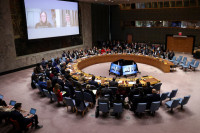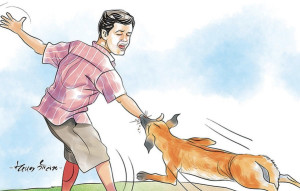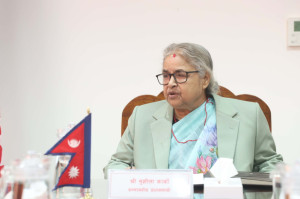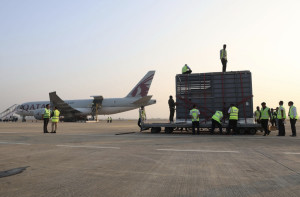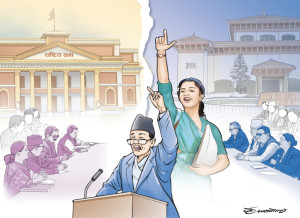Columns
Regional security after Taliban takeover
Nepal needs to be concerned about its preparedness for preventing and countering violent extremism.
Surendra Shah & Bam bahadur Bhandari
The rapidity of events in Afghanistan surrounding the fall of the Ghani-led government to the Taliban took everyone by surprise. Now the shock of the transition is being met with the pragmatism of coping with the aftermath of the collapse. Among various realistic scenarios that can be envisaged in the aftermath are those of in-country humanitarian crises, refugees fleeing the Taliban, and the proliferation of violent extremist groups, directly supported or inspired by the Taliban’s success against the world’s only superpower.
As a least developed country with limited ability to lend support during humanitarian and refugee crises, Nepal has made token gestures of solidarity in the past to regional and international crises, and has not really taken a strategic approach to such actions. However, the third scenario that can be envisaged in the aftermath of the Taliban takeover—the proliferation of violent extremists—will require sober consideration of the immediate and long-term security implications for Nepal.
Violent extremism
Nepal’s connection to violent extremists was the subject of a United States Department of State cable sent in 1997 by the then US Ambassador to India, Frank Wisner, mentioning how Nepal was being used as a launch pad for anti-India activities. In the cable, Wisner claimed that terrorists had used “vulnerable Kathmandu-based Kashmiri businessmen” to dispatch “men and material to execute explosions in India”. Indeed, during the 1990s, the movement of violent extremist elements—both personnel and equipment—was detected in Nepal.
The incident that put Nepal on the global violent extremism map occurred in December 1999, with the hijacking of Indian Airlines flight IC 814 from Kathmandu. The Taliban subsequently assisted the hijackers to land in Kandahar, Afghanistan, and also facilitated their negotiations with the Indian government to release three Harkat-ul-Mujahideen members.
Nepal’s security agencies have worked closely with foreign counterparts in preventing and countering violent extremism in recent years. This collaboration has occurred despite a glaring lack of legal and policy support across government for securing the country against violent extremists. Laws are lacking that specifically enable detection and provide for judicious detention, prosecution and extradition of violent extremist suspects, and secure official personnel and material. This overall lack of policy and political support has resulted in limited investment in preventing and countering violent extremism and a reluctance to cooperate across government. Whereas there are designated anti-terrorism or counterterrorism units now in all four security agencies, they are undermanned and underequipped.
Minimal coordination among security-related agencies as well as other movement-related agencies, for a variety of reasons, exacerbates the incapacity caused by scarcity of personnel and material. The absence of integrated procedures that require operational linkage and coordination of various agencies is the primary constraint to implementing more robust counter and anti-terrorism security measures. Tribhuvan International Airport, the country’s only international airport, illustrates fundamental weaknesses in security-related capacity and coordination: Passenger screening systems—like the Advanced Passenger Information System (APIS)—are not used, nor are biometric and document verification tools; physical checks of persons and spaces are rudimentary and variable; sterile, holding areas to separate travellers and baggage are easily breached; and immigration and customs personnel are neither oriented towards preventing and countering violent extremism nor vetted for vulnerabilities.
The softness in Nepali security derives significantly from both lack of technical capability and lack of jointness in operation. If they are not addressed immediately, Nepal can easily turn from being a staging point to a direct casualty of violent extremists.
Getting the basics right
Given Nepal’s encounters with violent extremist activities, transient populations and ease of mobility across borders, it is imperative to step outside of a traditional understanding of security and rapidly upgrade Nepal’s readiness to address violent extremism.
First, Nepal has to get all the basics related to counterterrorism security measures right. This has to start with legal instruments explicitly defining terrorism and provisioning legal coverage for related actions.
Second, capacity should be built and strengthened for terrorism prevention-related monitoring and verification measures within Tribhuvan International Airport and at Nepal’s land borders. Alongside quality personnel and equipment, there needs to be increased collaboration and cooperation with international agencies and also operational jointness among traditional and non-traditional national security agencies, departments and units in the country.
Given that the flow of money is crucial for violent extremist groups to plan and execute terrorist acts, establishing jointness with the Financial Information Unit of Nepal Rastra Bank will enhance effective tracking of suspicious financial transactions. This level of jointness is not possible without integrated terror-related security policies that bring various non-traditional security agencies under a common umbrella for preventing and countering violent extremism.
Third, there should be periodic exercises simulating possible terrorist attacks. The purpose of these exercises should be to test and clarify the roles and responsibilities of security-related agencies and concerned government authorities in the event of an actual attack. The simulated testing and clarification of roles and responsibilities will also point to potential avenues for joint operations among security agencies, departments and units. Given Nepal’s lack of experience in dealing with terrorist attacks, these roles and responsibilities were developed on an ad hoc basis, and are currently unclear, overlapping and conflicting.
Finally, the security threat to Nepal posed by violent extremism must be taken seriously by all political parties, not just security agencies and the executive branch of the government. A whole of government approach supported by political parties is required for preventing and countering violent extremism in all its forms.
The Taliban’s recent success against superior, international forces including the United States has boosted the morale of violent extremist groups. The recent declaration by ISIS-K of an adjustment in strategy to include areas like Kashmir will likely foment violent extremist activities in the South Asian region. Despite their assurances that Afghanistan will not be used by terror groups, it will be difficult for the Taliban to sever ties with extremist groups and their sponsors. In this context, countries in and around South Asia should be extra vigilant.




 4.91°C Kathmandu
4.91°C Kathmandu

